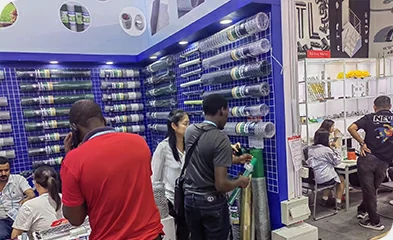The Art of Chain Link Fence Installation A Comprehensive Guide
Chain link fences are a popular choice for both residential and commercial properties due to their durability, affordability, and versatility. Installing a chain link fence requires precision, patience, and a good understanding of the process. Here's a detailed guide to help you navigate through the installation journey.
Firstly, begin with measuring the area where you plan to install the fence. This will give you an estimate of the materials you'll need, including the length of the chain link fabric, posts, and gates. Remember, it's always better to have a little extra material than to fall short.
The next step is digging the post holes. Posts are typically set in concrete for stability. For a standard 4-foot fence, the holes should be around 3 feet deep, while for a 6-foot fence, they should be 4 feet deep. Make sure the holes are wide enough to accommodate the post plus an additional 6 inches on all sides.
Once the holes are dug, insert the posts and fill them with concrete. Allow the concrete to set for at least 24 hours before proceeding. This curing time ensures the posts are securely anchored in place.
After the posts have set, it's time to stretch the fence. Start by attaching the tension bar to the terminal post (the end or corner post). Unroll the chain link fabric along the line of the posts, attaching it to each post as you go using wire ties Unroll the chain link fabric along the line of the posts, attaching it to each post as you go using wire ties

Unroll the chain link fabric along the line of the posts, attaching it to each post as you go using wire ties Unroll the chain link fabric along the line of the posts, attaching it to each post as you go using wire ties
 chain fence installation
chain fence installation. Be sure to maintain consistent tension while stretching the fence. This is crucial for a straight and sturdy fence.
Next, install the gate hardware. Gates require additional support and hardware such as hinges and a latch. Follow the manufacturer's instructions carefully to ensure proper installation and functionality.
Finally, apply a tension wire to the top of the fence and tighten it using a tensioning device. This helps keep the fence taut and prevents sagging over time. Cut off any excess fabric and secure it with wire ties.
Remember, safety is paramount during this process. Wear protective gear, use appropriate tools, and if possible, work with a partner for heavy lifting and to avoid potential hazards.
In conclusion, chain link fence installation might seem daunting at first, but with careful planning, the right tools, and a bit of elbow grease, it can be a rewarding DIY project. However, if you're not comfortable with the process, it's always advisable to seek professional assistance. A well-installed chain link fence not only enhances the security and aesthetics of your property but also provides a low-maintenance solution for years to come.
 TEL:
+86-13102802206
TEL:
+86-13102802206
 Email:
fencenetting@china.com
Email:
fencenetting@china.com
 Language
Language
 TEL:
+86-13102802206
TEL:
+86-13102802206
 Email:
fencenetting@china.com
Email:
fencenetting@china.com
 Language
Language


 Unroll the chain link fabric along the line of the posts, attaching it to each post as you go using wire ties Unroll the chain link fabric along the line of the posts, attaching it to each post as you go using wire ties
Unroll the chain link fabric along the line of the posts, attaching it to each post as you go using wire ties Unroll the chain link fabric along the line of the posts, attaching it to each post as you go using wire ties chain fence installation. Be sure to maintain consistent tension while stretching the fence. This is crucial for a straight and sturdy fence.
Next, install the gate hardware. Gates require additional support and hardware such as hinges and a latch. Follow the manufacturer's instructions carefully to ensure proper installation and functionality.
Finally, apply a tension wire to the top of the fence and tighten it using a tensioning device. This helps keep the fence taut and prevents sagging over time. Cut off any excess fabric and secure it with wire ties.
Remember, safety is paramount during this process. Wear protective gear, use appropriate tools, and if possible, work with a partner for heavy lifting and to avoid potential hazards.
In conclusion, chain link fence installation might seem daunting at first, but with careful planning, the right tools, and a bit of elbow grease, it can be a rewarding DIY project. However, if you're not comfortable with the process, it's always advisable to seek professional assistance. A well-installed chain link fence not only enhances the security and aesthetics of your property but also provides a low-maintenance solution for years to come.
chain fence installation. Be sure to maintain consistent tension while stretching the fence. This is crucial for a straight and sturdy fence.
Next, install the gate hardware. Gates require additional support and hardware such as hinges and a latch. Follow the manufacturer's instructions carefully to ensure proper installation and functionality.
Finally, apply a tension wire to the top of the fence and tighten it using a tensioning device. This helps keep the fence taut and prevents sagging over time. Cut off any excess fabric and secure it with wire ties.
Remember, safety is paramount during this process. Wear protective gear, use appropriate tools, and if possible, work with a partner for heavy lifting and to avoid potential hazards.
In conclusion, chain link fence installation might seem daunting at first, but with careful planning, the right tools, and a bit of elbow grease, it can be a rewarding DIY project. However, if you're not comfortable with the process, it's always advisable to seek professional assistance. A well-installed chain link fence not only enhances the security and aesthetics of your property but also provides a low-maintenance solution for years to come.